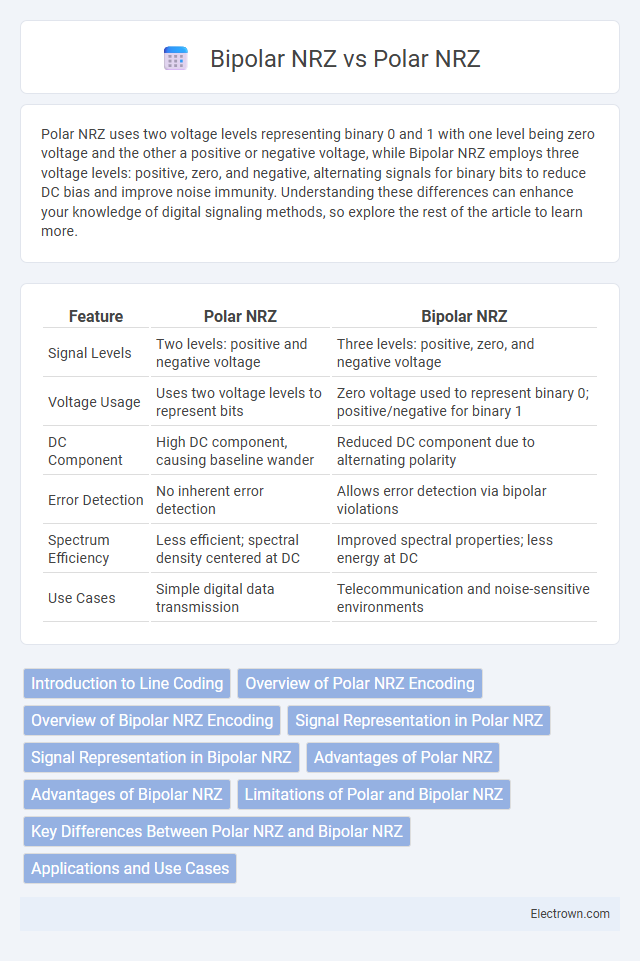Polar NRZ uses two voltage levels representing binary 0 and 1 with one level being zero voltage and the other a positive or negative voltage, while Bipolar NRZ employs three voltage levels: positive, zero, and negative, alternating signals for binary bits to reduce DC bias and improve noise immunity. Understanding these differences can enhance your knowledge of digital signaling methods, so explore the rest of the article to learn more.
Table of Comparison
| Feature | Polar NRZ | Bipolar NRZ |
|---|---|---|
| Signal Levels | Two levels: positive and negative voltage | Three levels: positive, zero, and negative voltage |
| Voltage Usage | Uses two voltage levels to represent bits | Zero voltage used to represent binary 0; positive/negative for binary 1 |
| DC Component | High DC component, causing baseline wander | Reduced DC component due to alternating polarity |
| Error Detection | No inherent error detection | Allows error detection via bipolar violations |
| Spectrum Efficiency | Less efficient; spectral density centered at DC | Improved spectral properties; less energy at DC |
| Use Cases | Simple digital data transmission | Telecommunication and noise-sensitive environments |
Introduction to Line Coding
Polar NRZ (Non-Return-to-Zero) line coding utilizes two voltage levels, positive and negative, representing binary 1 and 0, optimizing signal detection and reducing DC components in data transmission. Bipolar NRZ alternates between positive and negative voltages for binary 1, with zero voltage representing binary 0, which helps to minimize baseline wander and supports error detection through violation pulses. Both line coding schemes enhance bandwidth efficiency and signal integrity in digital communication systems by encoding data into electrical signals for transmission.
Overview of Polar NRZ Encoding
Polar NRZ encoding represents digital data using two distinct voltage levels: a positive voltage for a binary 1 and a negative voltage for a binary 0, ensuring a clear and straightforward signal interpretation. This method contrasts with Bipolar NRZ, which uses alternating positive and negative voltages for binary 1s while zero volts represent binary 0s, reducing DC bias and improving error detection. Understanding Polar NRZ's voltage representation helps you optimize signal processing in digital communication systems where simplicity and reliability are essential.
Overview of Bipolar NRZ Encoding
Bipolar NRZ encoding uses three voltage levels: positive, negative, and zero, where logical '1's alternate between positive and negative voltages, and logical '0's remain at zero volts. This alternating pattern reduces DC bias and facilitates error detection by leveraging signal polarity changes. Bipolar NRZ is commonly employed in telecommunications to improve signal reliability over long distances compared to Polar NRZ encoding, which uses only positive and zero voltage levels.
Signal Representation in Polar NRZ
Polar NRZ signal representation uses two distinct voltage levels, typically positive and negative, to indicate binary states, with no neutral or zero voltage level. The presence of a positive voltage signals a binary '1', while a negative voltage represents a binary '0', enabling clear differentiation between bits without a baseline or zero level. This bipolar signaling method reduces baseline wander and improves error detection compared to unipolar NRZ encoding techniques.
Signal Representation in Bipolar NRZ
Bipolar NRZ signal representation uses three voltage levels: positive, zero, and negative, where logical '1's alternate between positive and negative voltages and logical '0's are denoted by zero voltage. This alternation reduces DC bias and improves error detection by allowing the receiver to identify bipolar violations. Bipolar NRZ enhances signal integrity in transmission lines compared to Polar NRZ, which uses only two voltage levels without polarity alternation.
Advantages of Polar NRZ
Polar NRZ encoding offers higher signal amplitude levels compared to Bipolar NRZ, resulting in improved noise immunity and better signal detection over long distances. Its consistent positive and negative voltage levels simplify receiver design and reduce timing errors, enhancing data integrity. Polar NRZ's straightforward structure enables efficient bandwidth utilization, making it ideal for high-speed data transmission systems.
Advantages of Bipolar NRZ
Bipolar NRZ offers distinct advantages over Polar NRZ, including reduced DC component and improved signal integrity, which minimizes baseline wander and enhances long-distance transmission reliability. Its inherent ability to detect errors through polarity violations helps maintain data accuracy without additional overhead. This encoding also supports better electromagnetic compatibility by balancing the signal's voltage levels, decreasing interference in communication systems.
Limitations of Polar and Bipolar NRZ
Polar NRZ suffers from baseline wander and lacks inherent error detection capabilities, making it vulnerable to synchronization issues in long transmission runs. Bipolar NRZ reduces DC component and mitigates baseline wander by alternating signal polarity, but it still faces limitations such as susceptibility to noise and limited error detection in long sequences without transitions. Both encoding schemes struggle with long strings of identical bits, leading to potential clock recovery problems in high-speed digital communication.
Key Differences Between Polar NRZ and Bipolar NRZ
Polar NRZ encodes binary data using two voltage levels: positive for binary 1 and negative for binary 0, resulting in a direct representation of the data signal. Bipolar NRZ employs three voltage levels: positive, zero, and negative, alternating the polarity of binary 1s while binary 0s are transmitted as zero voltage, which reduces DC component and improves synchronization. The primary difference lies in signal polarity usage and baseline voltage, with Bipolar NRZ offering better error detection and reduced baseline wander compared to Polar NRZ.
Applications and Use Cases
Polar NRZ is widely used in digital communication systems such as Ethernet and serial data transmission due to its simpler implementation and efficient bandwidth usage. Bipolar NRZ finds applications in systems requiring error detection without additional overhead, like T-carrier and E-carrier telecommunications, as its alternating polarity helps identify signal integrity issues. Both encoding schemes are favored in scenarios where minimizing DC components and maintaining synchronization are critical for performance.
Polar NRZ vs Bipolar NRZ Infographic

 electrown.com
electrown.com